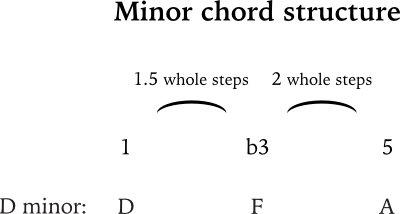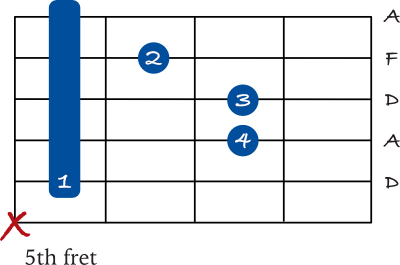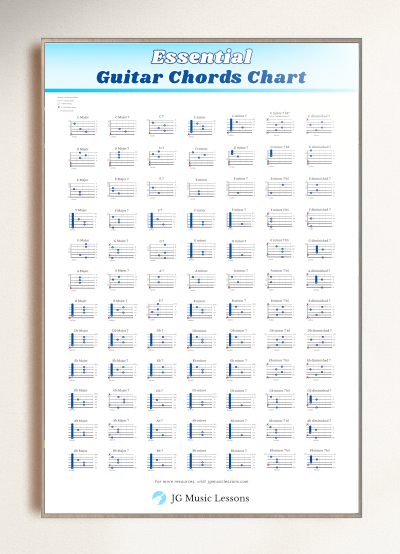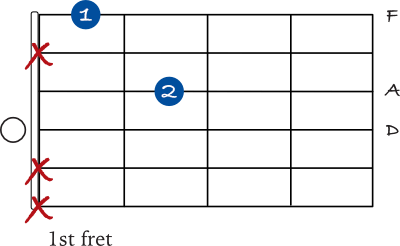The D minor chord is one of the first chords you should learn on guitar. You may also see this written as Dm or D min on sheet music.
This chord has an easy open chord shape but there are many different ways you can play it throughout the guitar fretboard. By knowing different chord variations, you’ll be able to use it in different musical contexts.
This lesson covers 11 ways to play a D minor chord which you can start to incorporate to your playing.
Grab your guitar and let’s get started!
D minor chord theory intro
Let’s first look at some basic theory to understand this chord.
Minor triad chords are built on the chord tones 1, b3, and 5. These chord tones can also be thought of as the scale degrees related to one minor scale.
For example, the D minor chord has the chord tones D, F, and A.
Here is the formula for minor chords below.

In contrast, Major triad chords contain the chord tones 1, 3, and 5. For example, D Major chord would contain the chord tones D, F#, and A. However, we will only be covering the different minor chord variations in this lesson.
Now that you know what notes belong to the chord structure let’s look at how to read the chord charts.
How to read the chord charts
For the charts below:
- The top horizontal line of the chord chart represents the high E string and the bottom horizontal line represents the low E string.
- The vertical lines separate each fret.
- The numbers in the blue dots tell you which fingers to use on the fretting hand.
- The letters on the right of the charts tell you what notes you are playing on each string.
- Circles on the left represent open strings.
- Red X means to avoid that string.
You can check this link for more on how to read guitar notation symbols.
D minor open chord
This is the first way I recommend learning a D minor chord. You will often use this chord along with other basic open chords when strumming or picking.

D minor triad chord
Another easy way to play a D minor chord is using this simple triad shape starting on the 3rd string. We’ll build upon this shape ahead to make this sound fuller.

D minor triad chord adding pinky
We can also add the pinky finger within the previous chord shape like this:

D minor chord on 5th string (no barre)
Before we get to barre chords, you can use this shape which starts on the 5th string, 5th fret.

D minor barre chord on the 5th string
This barre chord shape comes from the open A minor chord except you have to rearrange your fingers as you barre the 5th fret with your 1st finger.

If you can’t get the note on the 1st string to sound clear, you can play this chord without the barre and only play the notes from the 5th to the 2nd string (as shown in the previous chart). Then, you can come back to this chord shape as you develop more strength in your fretting hand.
D minor chord on the 4th string
This chord shape uses a half barre on the 10th fret. You could also replace the 3rd finger with an open D string since it belongs to the chord.

D minor chord variation (D/A)
Building upon the previous chord shape, you can also add the 3rd finger to the 5th string. Technically, this can be called a D minor in 2nd inversion because the 5th of the chord is in the bass.

You can also check out this other lesson for more on how to play chord inversions on the guitar.
D minor barre chord 6th string
At this point, we’ve worked on different steps to take before getting to this chord because it requires more strength in your fretting hand. This shape comes from the open E minor chord except you have to rearrange your fingers as you barre the 10th fret with your 1st finger.

You may also want to check out 5 tips to get better at playing barre chords on guitar.

Spread chord shapes
The following chords are called spread shapes because of the wider space between some of the notes within the chord shape. Because these chord shapes skip a string, they are more suitable for a finger picking style of playing. You might also hear these chords in a more classical music context.
To go more in-depth, check out this lesson on how to play spread triad chords on guitar.
D minor spread chord on the 6th string

D minor spread chord on the 5th string

D minor spread chord on the 4th string

Wrapping up
All these chords were mostly in root position, meaning the root note is in the bass. However, you certainly have more variations if you use different chord inversions. This is when you play a chord with notes other than the root.
It’s good to know many possibilities of playing the same chord because you have more flexibility to move around the fretboard. Also, you can use different chord variations when you need a certain note at the top to help define a melody that you are playing over.
I hope this helped you understand how to play a D minor guitar chord or learn new ways of playing it. You can also try shifting the shapes that have all fretted notes to play other minor chords on the same string.
To learn more advanced chords, check out how to play a D minor 7, D Major 7, or D 7 chord on guitar.
📘 Get the free guitar practice guide here!
All the best,
JG Music Lessons
Start Playing Better, Faster
with Pro Membership! ✨
Get the guidance, tools, and support that keep your progress on track:
🏁 Always know what to practice next. Access the full Guitar Learning Roadmap with lessons in sequence.
🎼 Play songs with confidence. Step-by-step lessons of popular, classical pieces and other styles.
📙 Save time and frustration. Clear PDFs and ebooks that save time so you can focus on playing.
🎟️ Get rewarded for consistency. 2 free downloads every month (a $240+ yearly value).
🎁 Keep costs low while you grow. 50% off all charts, tracks, and posters — up to 75% off bundles.
🚫 Stay focused. Ad-free environment keeps you in the zone.
💬 Get help when you need it. Direct member support to keep you on track.

